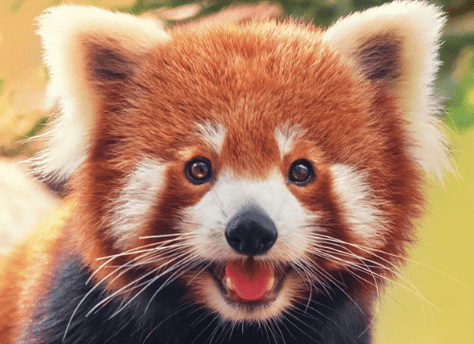Nature has a habit of presenting us with conundrums. From flightless birds to duck-billed mammals, to sprinting tortoises (yes, they exist!), we are constantly astounded and rewarded when Mother Nature reveals her rule-breaking handiwork. As humans, we crave order. We want a nice, logical place for everything and everything in its place. Thank goodness nature embraces originality and innovation because it’s through these rule-breaking creatures and the, can’t-quite-put-a-name-to-a-face beasts, that we learn so much.
Leading the ranks of these species is Ailurus fulgens or the Red Panda. This medium-sized mammal is widely known by all, yet simultaneously, well understood by few. Commonly called cat-bear, Firefox and Lesser Panda (they’re particularly sensitive about this one), the Red Panda is related to many, more familiar beasts. Distantly related to Giant Pandas, and closer kin to raccoons, Red Pandas are the only living member of their taxonomic family, the Ailuridae. Not surprisingly, the Red Panda possesses familiar and highly advantageous traits from their distant cousins. From its stocky, bear-shaped body, to its foxlike ears, and ringed, raccoon-like tail, this modest beast is superbly adapted to an arboreal life among the cool mountainous forests of the Himalayan region.
Originally classified as a carnivore, the Red Panda possesses stout jaws and sharp teeth yet these omnivores prefer to eat tender bamboo shoots and leaves over meat, 98% of the time. Rounding out their diet with the occasional fruit, insect, bird egg, bird or small mammal, Red Pandas adapt well to seasonal scarcity and abundance, exploiting available food sources. Reaching 3.5 feet in length and tipping the scales at 7-14 pounds, the panda is the size of a fox. Like its distant cousin the Red Fox, this beast also sports a flaming red coat with occasional gold highlights. Rounding out its appearance, the panda possesses a pointy snout, white patches of facial fur, black fur extending to its legs and bear-like paws, and a long ringed bushy tail, tipped with black or white. This coloration actually aids them as camouflage among the reddish-brown mosses and white lichens in the Fir canopy of their native forests.
A closer look reveals a creature boasting specialized skills. The panda’s reddish-brown “tear marks” extend from its eyes to the corners of its mouth and serve to keep the sun’s glare out of its eyes. The raccoon-like tail aids in providing both exceptional balance high above the forest floor, and in warming the panda’s face and body when draped over to conserve warmth. Semi-retractable claws provide excellent gripping capability when climbing and the panda’s extraordinarily flexible ankles enable this beast to climb headfirst down tree trunks. Like Giant Pandas, they possess a modified wrist bone known as a pseudo-thumb which enables them to grasp and manipulate bamboo and other foods, with deft, nearly hand-like ability. Though crepuscular, or active at dawn and dusk periods, Red Pandas modify their schedules and activity to conserve energy. Colder temperatures prompt temporary dormancy, yet under such conditions, the panda remarkably raises its metabolic rate every few hours to search for food.
My work confers the privilege of working with animals such as the Red Panda. They are part of a program known as an S.S.P. or Species Survival Plan, a highly-coordinated worldwide effort—administered regionally at Connecticut’s Beardsley Zoo—to breed endangered creatures, educate guests and restore species populations to the wild. Over the years, I’ve found that when guests can relate to an animal or species, they are far more likely to protect them. It’s natural to want to protect what we have grown to understand and love…or at least care about.
The Red Panda is considered one of the world’s few “Peter Pan” animals who never outgrows it’s youthful appearance…and it is precisely this fact that aids this animal who needs all the help it can muster. With a habitat under increasing threat from climate shift, illegal logging and other environmental degradation, the Red Panda needs a superpower. Enter cuteness. In nature, cute doesn’t exactly yield dividends, yet in the human world, cute can engender caring, rally support, and generate conservation action. As a species, when we protect cute, we extend that protection to all of the plants and animals who live in the same habitat. For every Red Panda or Sugar Glider, there is an Atlantic Hagfish or Marabou Stork benefitting from their more photogenic neighbors.
In the panda, we see a creature who is not quite what it seems on the surface. We encounter a beast with one set of obvious characteristics and another, more discrete compliment of on-demand traits which it employs with great effect. Perhaps not the boldest creature, but highly capable when necessary. Familiar to most but truly understood by few. It is a rule-breaking innovator when the situation calls for it and a creature whose appeal belies its capability. Equal parts fierce and cute…the Red Panda gains both our respect and our caring. Perhaps in the panda, we see a bit of ourselves. If you haven’t become acquainted with these humble creatures, I encourage you to take some time out of your busy week to visit them, read about them, check out a “Panda Cam” or otherwise get to know the little beast behind that adorable face.
Jim Knox serves as the Curator of Education for Connecticut’s Beardsley Zoo and as a Science Adviser for The Bruce Museum. His passions include studying our planet’s rarest creatures and sharing his work with others who love the natural world.






